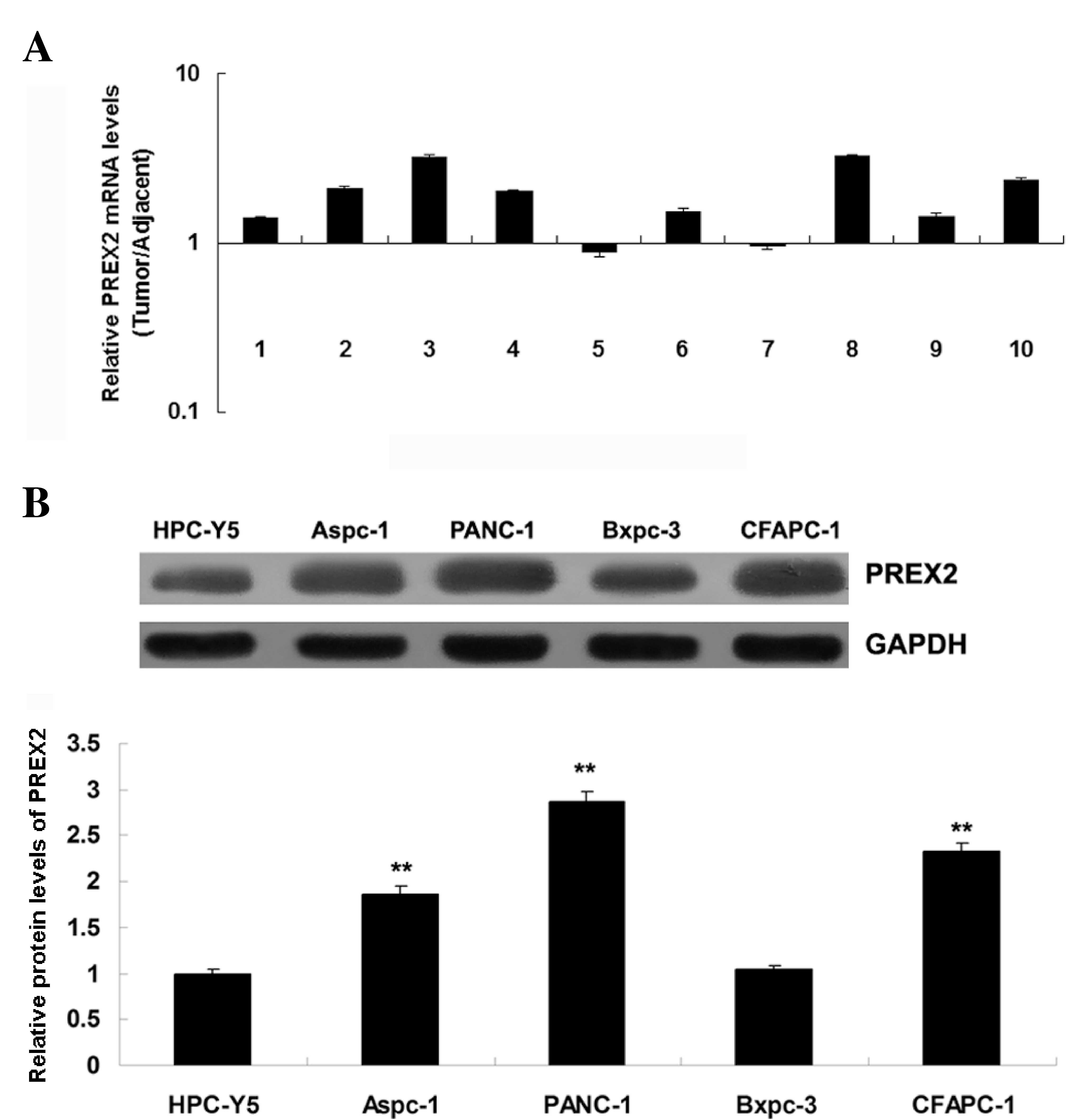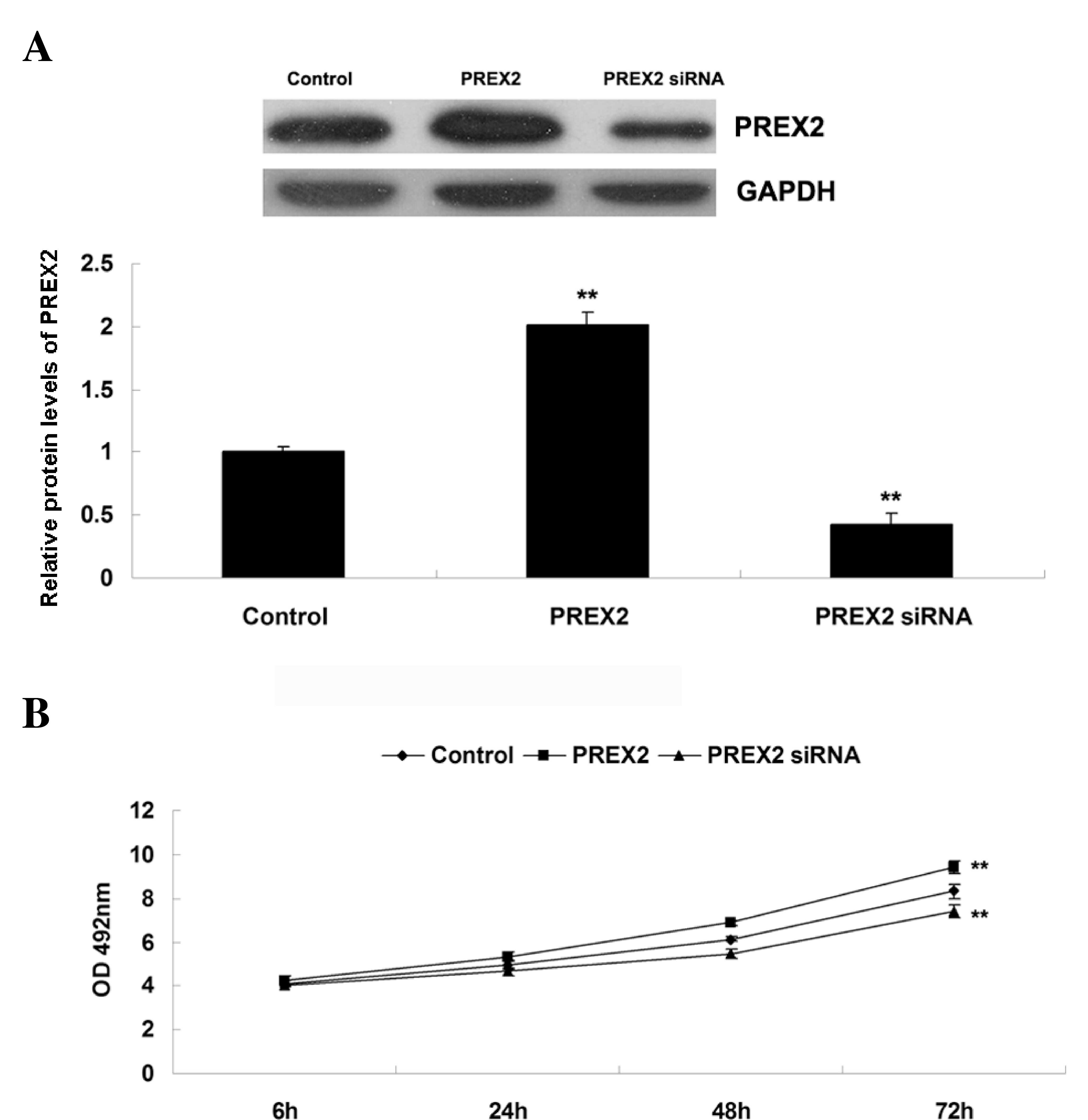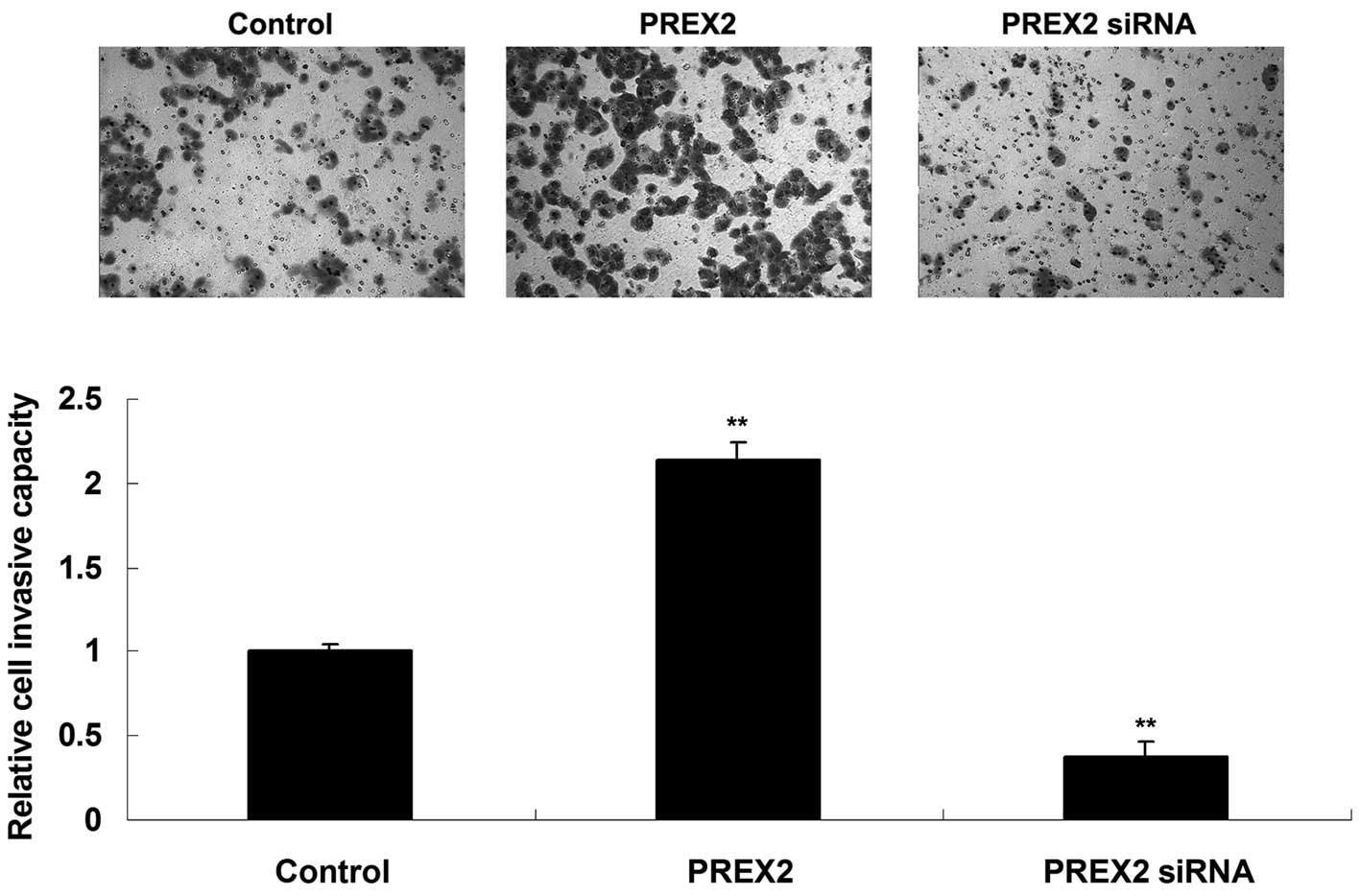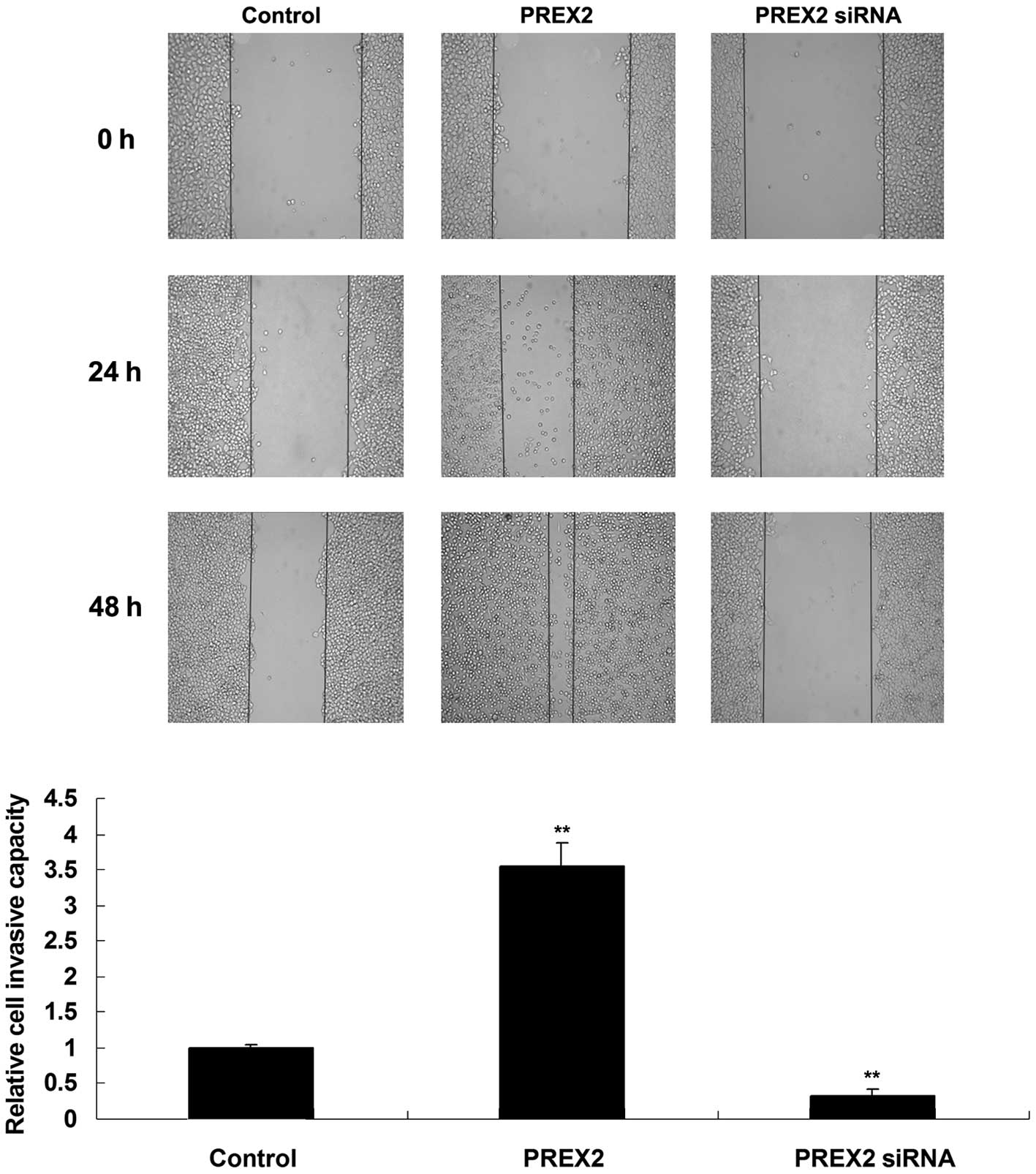PREX2 promotes the proliferation, invasion and migration of pancreatic cancer cells by modulating the PI3K signaling pathway
Retraction in: /10.3892/ol.2021.12917
- Authors:
- Published online on: June 8, 2016 https://doi.org/10.3892/ol.2016.4688
- Pages: 1139-1143
Abstract
Introduction
Pancreatic cancer is one of the most common types of human cancer, with a 5-year overall survival rate of only 5% (1). Even among those patients who undergo resection and have tumor-free margins, the 5-year survival rate is only 10–25% (1). Despite the fact that combined surgery, radiotherapy and chemotherapy have been applied for >30 years, no significant improvement has been obtained in the treatment of metastatic pancreatic cancer (2–4). As the dysregulation of oncogenes or tumor suppressor genes has been observed to play key roles in pancreatic cancer, the development of potential molecular targets is a promising approach to achieve effective therapies for pancreatic cancer (5).
The phosphoinositide 3-kinase (PI3K) signaling pathway has been demonstrated to be frequently dysregulated in various types of human cancer, including pancreatic cancer (6–8). Aberrant activation of PI3K signaling promotes cancer cell proliferation, invasion and migration (9–11). Phosphatase and tensin homolog (PTEN) is able to antagonize PI3K signaling, thus acting as an inhibitor of the PI3K signaling pathway (12). However, PTEN is frequently mutated or its activity is downregulated in human cancer (13,14). Phosphatidylinositol-3,4,5-trisphosphate-dependent Rac exchanger factor 2 (PREX2) is a regulator of the small guanosine triphosphatase Rac, and has recently been reported to act as an inhibitor of PTEN (15,16). PREX2 is able to inhibit the activity of PTEN by directly binding to PTEN through its guanine nucleotide exchange factor domains. Through inhibition of PTEN activity, PREX2 is capable of activating the downstream PI3K signaling pathway (15,16). Indeed, it has been reported that knockdown of PREX2 inhibits the invasion and clonogenicity of gastric cancer cells via inhibition of PI3K signaling (17). In addition, silencing of PREX2 could also induce cell cycle arrest at the G1-S phase and promote apoptosis in gastric cancer cells (17). Since the dysregulation of the PI3K signaling pathway has been demonstrated to be involved in multiple types of human cancer, PREX2 may generally act as an oncogene in tumorigenesis (16).
However, the detailed role of PREX2 in pancreatic cancer has never been previously reported. Therefore, the present study aimed to explore the role of PREX2 in the regulation of pancreatic cancer cell invasion and migration, and to identify the underlying molecular mechanisms.
Materials and methods
Reagents
Dulbecco's modified Eagle's medium (DMEM), fetal bovine serum (FBS) and Lipofectamine 2000 were purchased from Thermo Fisher Scientific, Inc. (Waltham, MA, USA). RNAeasy Mini kit was purchased from Qiagen, Inc. (Valencia, CA, USA). PrimeScript™ RT reagent kit was purchased from Takara Bio, Inc. (Otsu, Japan). iQ™ SYBR® Green supermix was purchased from Bio-Rad Laboratories, Inc. (Hercules, CA, USA). All antibodies were purchased from Abcam (Cambridge, MA, USA). Enhanced chemiluminescence (ECL) kit was purchased from Pierce (Thermo Fisher Scientific, Inc.). Transwell chambers were purchased from Corning Incorporated (Corning, NY, USA). PREX2 small interfering (si)RNA was purchased from Santa Cruz Biotechnology, Inc. (Dallas, TX, USA). PREX2 plasmid was purchased from DNASU Plasmid Repository (Tempe, AZ, USA).
Tissue specimens
The present study was approved by the Ethics Committee of Central South University (Changsha, China). Written informed consent was obtained from each patient. A total of 10 primary pancreatic cancer tissues and their matched normal adjacent specimens were collected between March and September 2013. The histomorphology of all samples was confirmed at the Department of Pathology of Xiangya Hospital of Central South University (Changsha, China). Tissues were immediately snap frozen in liquid nitrogen following surgical removal.
Cell culture
The human pancreatic cancer cell lines AsPC-1, BxPC-3, PANC-1 and CFAPC-1, and the normal pancreatic epithelial cell line HPC-Y5, were obtained from the Cell Bank of Central South University (Changsha, China). Cells were cultured in DMEM with 10% FBS at 37°C in a humidified incubator containing 5% CO2.
Reverse transcription-quantitative polymerase chain reaction (RT-qPCR) analysis
Total RNA was isolated using RNAeasy Mini kit, according to the manufacturer's protocol. First-strand complementary (c)DNA was generated using PrimeScrip™ RT reagent kit, according to the manufacturer's protocol. PCR was conducted using 2 µl cDNA, 0.2 µl sense and antisense primers, and iQ™ SYBR® Green supermix on a 7500 Fast Real Time PCR system (Applied Biosystems, Thermo Fisher Scientific, Inc.). The PCR parameters were as follows: 50°C for 2 min, 95°C for 2 min, and 40 cycles of 95°C for 15 sec and 60°C for 1 min. Glyceraldehyde 3-phosphate dehydrogenase (GAPDH) was used as an internal control. Gene expression was determined by the 2−ΔΔCq method, where ΔCq = (Cqgene-CqGAPDH) and Cq is the threshold cycle. The specific primer pairs used were as follows: PREX2 sense, 5′-TGGGAGGGGTCCAACATCA-3′ and anti-sense, 5′-TCTTCAACCGTCTGTGTTTTCTT-3′; and GAPDH sense, 5′-CTCCTCCTGTTCGACAGTCAGC-3′ and anti-sense, 5′-CCCAATACGACCAAATCCGTT-3′.
Transfection
Lipofectamine 2000 was used to perform cell transfection following the manufacturer's protocol. Briefly, PREX2 siRNA, PREX2 plasmid and Lipofectamine 2000 were diluted with serum-free medium. Diluted Lipofectamine 2000 was added into the diluted PREX2 siRNA or PREX2 plasmid, and incubated for 20 min at room temperature, prior to be added to the cell suspension. Then, cells were incubated at 37°C with 5% CO2 for 6 h. Subsequently, the medium in each well was replaced by DMEM with 10% FBS, and cells were cultured for additional 24 h prior to be subjected to the corresponding assays.
Western blotting
Tissues and cells were solubilized in cold radioimmunoprecipitation assay lysis buffer. Proteins were separated by 10% sodium dodecyl sulfate-polyacrylamide gel electrophoresis, and then transferred onto a polyvinylidene difluoride membrane. The membrane was incubated overnight at 4°C with phosphate-buffered saline containing 5% milk. Subsequently, the membrane was incubated with Tris-buffered saline containing 5% milk at room temperature for 3 h, and then incubated with rabbit anti-PREX2 monoclonal antibody (ab169027; 1:100), rabbit anti-phosphorylated PTEN monoclonal antibody (ab109454; 1:50), rabbit anti-PTEN monoclonal antibody (ab32199; 1:50), rabbit anti-phosphorylated-AKT monoclonal antibody (ab81283; 1:50), rabbit anti-AKT monoclonal antibody (ab32505; 1:50) or rabbit anti-GAPDH monoclonal antibody (EPR16891; 1:100) at room temperature for 3 h, followed by incubation with rabbit anti-mouse secondary antibody (1:5,000; ab99697) at room temperature for 1 h, all from Abcam (Cambridge, UK). An ECL kit was then used for chemiluminent detection. Relative protein expression was analyzed by Image-Pro Plus software version 6.0 (Media Cybernetics, Inc., Rockville, MD, USA), and represented as the density ratio vs. GAPDH.
3-(4,5-dimethylthiazol-2-yl)-2,5-diphenyltetrazolium bromide (MTT) assay
MTT assay was used to measure cell proliferation. Cells in each group were cultured in 96-well plates, and 100 µl fresh serum-free medium with 0.5 g/l MTT was added to each well. Following incubation at 37°C for 6, 24, 48 and 72 h, the medium was removed by aspiration, and 50 µl dimethyl sulfoxide was added to each well. Upon incubation at 37°C for additional 10 min, the absorbance at 492 nm of each sample was measured using a plate reader.
Cell invasion assay
The invasive ability of PANC-1 cells was determined in 24-well Transwell chambers, which had a layer of Matrigel. A cell suspension was added in the upper chamber, while DMEM containing 10% FBS was added into the lower chamber. Following incubation for 24 h, non-invading cells and the matrix gel on the interior of the inserts was removed using a cotton-tipped swab. Invasive cells on the lower surface of the membrane were stained with gentian violet, rinsed with water and air-dried. Five fields were randomly selected, and the number of cells in those fields was counted under a microscope.
Wound healing assay
Wound healing assay was performed to evaluate cell migration. In brief, PANC-1 cells were cultured to full confluence. Wounds of ~1-mm width were created with a plastic scriber, and the cells were next washed and incubated in a serum-free medium. Upon wounding for 24 h, cells were incubated in a medium containing 10% FBS. Cultures at 0, 24 and 48 h were fixed and observed under a microscope.
Statistical analysis
All data are presented as the mean ± standard deviation. One-way analysis of variance was used to analyze statistically the data by SPSS version 17 software (SPSS, Inc., Chicago, IL, USA). P<0.05 was considered to indicate a statistically significant difference.
Results
PREX2 was frequently upregulated in pancreatic cancer
To study the role of PREX2 in pancreatic cancer, the expression of PREX2 in pancreatic cancer tissues and their matched adjacent normal tissues was determined by RT-qPCR. The data revealed that PREX2 was frequently upregulated in pancreatic cancer tissues, compared with the matched normal adjacent tissues (Fig. 1A). These findings suggest that dysregulation of PREX2 may play a role in pancreatic cancer. Subsequently, the expression of PREX2 in several human pancreatic cancer cell lines, including AsPC-1, BxPC-3, PANC-1 and CFAPC-1, was examined. The normal pancreatic epithelial cell line HPC-Y5 was used as control. Consistent with the tissue data, the expression of PREX2 was also frequently upregulated in pancreatic cancer cell lines, compared with normal pancreatic epithelial HPC-Y5 cells (Fig. 1B). As PANC-1 cells exhibited the most significant upregulation of PREX2 expression, this cell line was used in the following in-vitro studies.
Role of PREX2 in promoting pancreatic cancer cell proliferation
The role of PREX2 in the regulation of the proliferation of pancreatic cancer cells was further investigated. Firstly, pancreatic cancer PANC-1 cells were transfected with pcDNA3.1-PREX2 plasmid (Addgene, Inc., Cambridge, MA, USA) or PREX2-specifc siRNA to modulate the expression levels of PREX2. Upon transfection, western blot assay was performed to determine the expression of PREX2 in PANC-1 cells. As indicated in Fig. 2A, the protein levels of PREX2 were significantly increased in PANC-1 cells following transfection with pcDNA3.1-PREX2 plasmid, compared with the control group. By contrast, the protein levels of PREX2 were notably decreased in PANC-1 cells following transfection with PREX2-specific siRNA, compared with the control group. Subsequently, MTT assay was performed to determine the proliferation capacity of pancreatic cancer PANC-1 cells following upregulation or downregulation of PREX2. As represented in Fig. 2B, PANC-1 cell proliferation was significantly upregulated following overexpression of PREX2, while it significantly decreased upon inhibition of PREX2, compared with the control group. Based on these findings, it is possible to suggest that PREX2 plays a promoting role in the regulation of pancreatic cancer cell invasion.
Promoting role of PREX2 in pancreatic cancer cell invasion
Transwell assay was performed to determine the invasive capacity of pancreatic cancer PANC-1 cells following upregulation or downregulation of PREX2. As indicated in Fig. 3, the invasive capacity of PANC-1 cells was significantly upregulated following overexpression of PREX2, while it significantly decreased upon inhibition of PREX2, compared with the control group. These findings suggest that PREX2 plays a promoting role in the regulation of pancreatic cancer cell invasion.
Promoting role of PREX2 in pancreatic cancer cell migration
Wound healing assay was performed to determine the cell migratory capacity of PANC-1 cells following upregulation or downregulation of PREX2. As represented in Fig. 4, the migratory capacity of PANC-1 cells was downregulated upon knockdown of PREX2, but it was significantly upregulated following PREX2 upregulation, compared with the control group. Therefore, PREX2 is able to promote pancreatic cancer cell migration.
Effect of PREX2 on the activity of the PI3K signaling pathway in pancreatic cancer cells
PREX2 has been previously reported to act as an inhibitor of PTEN and an activator of the PI3K signaling pathway (15). However, the effect of PREX2 on PTEN and PI3K signaling has never been reported in pancreatic cancer. Therefore, the activity of PTEN and the PI3K signaling pathway in pancreatic cancer cells following upregulation or downregulation of PREX2 was further investigated in the present study. AKT is a downstream effector of PI3K, and its phosphorylation levels represent the activity of the PI3K signaling pathway. (15) The present data revealed that the phosphorylation levels of PTEN increased in PANC-1 cells that overexpressed PREX2, indicating that the activity of PTEN was reduced in these cells. Furthermore, the phosphorylation levels of AKT were increased, indicating that the activity of the PI3K signaling pathway was upregulated (Fig. 5). On the contrary, the inhibition of PREX2 led to reduced phosphorylation levels of PTEN, indicating that the activity of PTEN was upregulated. In addition, the phosphorylation levels of AKT were reduced, which indicated that the activity of the PI3K signaling pathway was decreased (Fig. 5). Based on these findings, it is possible to suggest that PREX2 could activate the PI3K signaling pathway via inhibition of PTEN activity in pancreatic cancer cells.
Discussion
PREX2 has been reported to be involved in several types of human cancer, including melanoma, gastric cancer, hepatocellular carcinoma and neuroblastoma (17–20). However, the detailed role of PREX2 in pancreatic cancer has not been previously reported. In the present study, the expression of PREX2 was demonstrated to be significantly increased in pancreatic cancer tissues compared with that in normal adjacent tissues. In addition, PREX2 expression was also frequently downregulated in pancreatic cancer cell lines compared with that in normal pancreatic epithelial cells. Furthermore, PREX2 was demonstrated to play a promoting role in the regulation of the proliferation, invasion and migration of pancreatic cancer cells, probably at least by suppressing the activity of PTEN and thus upregulating the activity of the PI3K signaling pathway.
Fine et al (21) revealed for the first time the inhibitory effect of PREX2 on PTEN. The authors noticed that PREX2 was more abundant in human cancer cells compared with normal cells, and was significantly upregulated in tumors with wild-type PTEN that expressed an activated mutant of phosphatidylinositol-4,5-bisphosphate 3-kinase catalytic subunit alpha, which encoded the p110 subunit of PI3Kα. In the present study, the expression of PREX2 was demonstrated to be frequently upregulated in pancreatic cancer tissues and cell lines, suggesting that PREX2 may be implicated in the tumorigenesis of pancreatic cancer. Fine et al (21) further demonstrated that only in the presence of PTEN, PREX2 could inhibit the lipid phosphatase activity of PTEN and stimulate the PI3K signaling pathway, thus suggesting that PREX2 is a component of the PI3K signaling pathway able to antagonize PTEN in cancer cells. In addition, P-REX2 has been observed to stimulate cell growth and growth factor-independent cell proliferation and transformation, and knockdown of PREX2 led to reduced growth of human cells with intact PTEN and reduced levels of phosphorylated AKT (21). In the present study, the downregulation of PREX2 notably suppressed pancreatic cancer cell proliferation.
Recently, the overexpression of P-Rex proteins has been linked to poor patient outcome in breast cancer, since it may facilitate metastatic dissemination of prostate cancer cells (16). Whole-genome sequencing identified PREX2 as a significantly mutated gene in melanoma, suggesting that PREX2 may also be involved in the development and progression of melanoma (18). Additionally, Chen et al (20) demonstrated that microRNA (miR)-338-3p could inhibit neuroblastoma cell proliferation, migration and invasion, and PREX2 was identified as a direct target of miR-338-3p. Knockdown of PREX2 inhibits cell proliferation, migration and invasion through the PTEN/AKT signaling pathway. Similarly, Guo et al (17) reported that miR-338-3p enhanced gastric cancer progression through PTEN-AKT signaling by targeting PREX2 in gastric cancer cells. However, the detailed role of PREX2 in the regulation of pancreatic cancer metastasis has not been previously reported. The present study demonstrated that PREX2 played a promoting role in the regulation of pancreatic cell proliferation and enhanced pancreatic cell migration and invasion, suggesting that the dysregulation of PREX2 may be involved in the metastasis of pancreatic cancer. Indeed, silencing of the PI3K/AKT signaling pathway has been observed to effectively inhibit the metastasis of pancreatic cancer (22,23).
In conclusion, the results of the present study revealed an oncogenic role of PREX2 in pancreatic cancer cells, and suggested that PREX2 may be a potential therapeutic target for pancreatic cancer.
References
|
Torre LA, Bray F, Siegel RL, Ferlay J, Lortet-Tieulent J and Jemal A: Global cancer statistics, 2012. CA Cancer J Clin. 65:87–108. 2015. View Article : Google Scholar : PubMed/NCBI | |
|
Páez D, Labonte MJ and Lenz HJ: Pancreatic cancer: Medical management (novel chemotherapeutics). Gastroenterol Clin North Am. 41:189–209. 2012. View Article : Google Scholar : PubMed/NCBI | |
|
Hidalgo M, Cascinu S, Kleeff J, Labianca R, Löhr JM, Neoptolemos J, Real FX, Van Laethem JL and Heinemann V: Addressing the challenges of pancreatic cancer: Future directions for improving outcomes. Pancreatology. 15:8–18. 2015. View Article : Google Scholar : PubMed/NCBI | |
|
Poruk KE, Firpo MA and Mulvihill SJ: Screening for pancreatic cancer. Adv Surg. 48:115–136. 2014. View Article : Google Scholar : PubMed/NCBI | |
|
Eser S, Schnieke A, Schneider G and Saur D: Oncogenic KRAS signalling in pancreatic cancer. Br J Cancer. 111:817–822. 2014. View Article : Google Scholar : PubMed/NCBI | |
|
Sun C, Rosendahl AH, Andersson R, Wu D and Wang X: The role of phosphatidylinositol 3-kinase signaling pathways in pancreatic cancer. Pancreatology. 11:252–260. 2011. View Article : Google Scholar : PubMed/NCBI | |
|
Dimitrova V and Arcaro A: Targeting the PI3K/AKT/mTOR signaling pathway in medulloblastoma. Curr Mol Med. 15:82–93. 2015. View Article : Google Scholar : PubMed/NCBI | |
|
Zhou SL, Zhou ZJ, Hu ZQ, Li X, Huang XW, Wang Z, Fan J, Dai Z and Zhou J: CXCR2/CXCL5 axis contributes to epithelial-mesenchymal transition of HCC cells through activating PI3K/AKT/GSK-3β/Snail signaling. Cancer Lett. 358:124–135. 2015. View Article : Google Scholar : PubMed/NCBI | |
|
Falasca M, Selvaggi F, Buus R, Sulpizio S and Edling CE: Targeting phosphoinositide 3-kinase pathways in pancreatic cancer-from molecular signalling to clinical trials. Anticancer Agents Med Chem. 11:455–463. 2011. View Article : Google Scholar : PubMed/NCBI | |
|
Ji BC, Hsiao YP, Tsai CH, Chang SJ, Hsu SC, Liu HC, Huang YP, Lien JC and Chung JG: Cantharidin impairs cell migration and invasion of A375.S2 human melanoma cells by suppressing MMP-2 and −9 through PI3K/NF-κB signaling pathways. Anticancer Res. 35:729–738. 2015.PubMed/NCBI | |
|
Massimiani M, Vecchione L, Piccirilli D, Spitalieri P, Amati F, Salvi S, Ferrazzani S, Stuhlmann H and Campagnolo L: Epidermal growth factor-like domain 7 promotes migration and invasion of human trophoblast cells through activation of MAPK, PI3K and NOTCH signaling pathways. Mol Hum Reprod. 21:435–451. 2015. View Article : Google Scholar : PubMed/NCBI | |
|
Carnero A and Paramio JM: The PTEN/PI3K/AKT pathway in vivo, cancer mouse models. Front Oncol. 4:2522014. View Article : Google Scholar : PubMed/NCBI | |
|
Xu J, Li Z, Wang J, Chen H and Fang JY: Combined PTEN mutation and protein expression associate with overall and disease-free survival of glioblastoma patients. Transl Oncol. 7:196–205. 2014. View Article : Google Scholar : PubMed/NCBI | |
|
Hühns M, Salem T, Schneider B, Krohn M, Linnebacher M and Prall F: PTEN mutation, loss of heterozygosity, promoter methylation and expression in colorectal carcinoma: Two hits on the gene? Oncol Rep. 31:2236–2244. 2014.PubMed/NCBI | |
|
Rosenfeldt H, Vazquez-Prado J and Gutkind JS: P-REX2, a novel PI-3-kinase sensitive Rac exchange factor. FEBS Lett. 572:167–171. 2004. View Article : Google Scholar : PubMed/NCBI | |
|
Pandiella A and Montero JC: Molecular pathways: P-Rex in cancer. Clin Cancer Res. 19:4564–4569. 2013. View Article : Google Scholar : PubMed/NCBI | |
|
Guo B, Liu L, Yao J, Ma R, Chang D, Li Z, Song T and Huang C: miR-338-3p suppresses gastric cancer progression through a PTEN-AKT axis by targeting P-REX2a. Mol Cancer Res. 12:313–321. 2014. View Article : Google Scholar : PubMed/NCBI | |
|
Berger MF, Hodis E, Heffernan TP, Deribe YL, Lawrence MS, Protopopov A, Ivanova E, Watson IR, Nickerson E, Ghosh P, et al: Melanoma genome sequencing reveals frequent PREX2 mutations. Nature. 485:502–506. 2012.PubMed/NCBI | |
|
Lan X, Xiao F, Ding Q, Liu J, Liu J, Li J, Zhang J and Tian DA: The effect of CXCL9 on the invasion ability of hepatocellular carcinoma through up-regulation of PREX2. J Mol Histol. 45:689–696. 2014. View Article : Google Scholar : PubMed/NCBI | |
|
Chen X, Pan M, Han L, Lu H, Hao X and Dong Q: miR-338-3p suppresses neuroblastoma proliferation, invasion and migration through targeting PREX2a. FEBS Lett. 587:3729–3737. 2013. View Article : Google Scholar : PubMed/NCBI | |
|
Fine B, Hodakoski C, Koujak S, Su T, Saal LH, Maurer M, Hopkins B, Keniry M, Sulis ML, Mense S, et al: Activation of the PI3K pathway in cancer through inhibition of PTEN by exchange factor P-REX2a. Science. 325:1261–1265. 2009. View Article : Google Scholar : PubMed/NCBI | |
|
Zhao H, Wang L, Wei R, Xiu D, Tao M, Ke J, Liu Y, Yang J and Hong T: Activation of glucagon-like peptide-1 receptor inhibits tumourigenicity and metastasis of human pancreatic cancer cells via PI3K/AKT pathway. Diabetes Obes Metab. 16:850–860. 2014. View Article : Google Scholar : PubMed/NCBI | |
|
Missiaglia E, Dalai I, Barbi S, Beghelli S, Falconi M, della Peruta M, Piemonti L, Capurso G, Di Florio A, delle Fave G, et al: Pancreatic endocrine tumors: Expression profiling evidences a role for AKT-mTOR pathway. J Clin Oncol. 28:245–255. 2010. View Article : Google Scholar : PubMed/NCBI |














